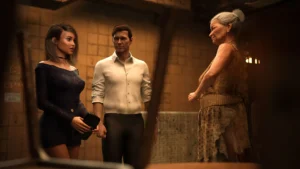
One Night Stand
Play One Night Stand
One Night Stand review
Explore the unique gameplay, story, and community behind the popular adult visual novel
If you’ve heard whispers about the ‘One Night Stand’ adult visual novel and are curious what all the buzz is about, you’re in the right place. Unlike typical games in this genre, ‘One Night Stand’ blends a gripping narrative with mature themes, meaningful choices, and a focus on emotional realism. In this article, we’ll dive into what makes this game unique, how its story and characters resonate with players, and why it’s become a standout title for fans of interactive fiction. Whether you’re a newcomer or a seasoned player, you’ll discover why ‘One Night Stand’ is more than just another adult game—it’s an experience that stays with you.
What Is the ‘One Night Stand’ Game All About?
Have you ever woken up with that heart-dropping, gut-churning feeling of “What did I do last night?” 😅 You’re in a strange room, your head is pounding, and there’s a complete stranger sleeping next to you. Your mind is a complete blank. That exact, universally terrifying (and let’s be honest, sometimes thrilling) moment is the entire premise of the “One Night Stand” visual novel, and it’s this brilliant, simple concept that hooks you from the very first click.
Unlike many games in its category, this isn’t about fantasy fulfillment or power trips. It’s a raw, awkward, and deeply human simulation of a situation many of us fear or have experienced. I remember my first playthrough; I was so nervous about clicking the wrong thing and offending my mysterious bedmate that I actually felt my palms get sweaty. That’s the power of its emotional realism in games—it makes you feel, not just play.
### A Fresh Take on Adult Visual Novels 🎭
When you hear the term “adult game story,” your mind might jump to certain conclusions. “One Night Stand” confidently smashes those expectations. 🚫 This isn’t a game filled with gratuitous content; it’s a thoughtful, narrative-driven experience that uses a mature premise to explore themes of connection, regret, curiosity, and social anxiety. The “adult” part comes from its handling of complex, real-world emotions and situations, not from sensationalism.
The genius of this “One Night Stand” visual novel is its restraint. The game forces you to sit in that uncomfortable morning-after silence. You have to look around the room for clues about your own identity and your companion’s. You have to make small talk, navigate landmines in conversation, and deal with the palpable awkwardness. It’s a masterclass in how mature themes in games can be explored with nuance and respect for the player’s intelligence. The focus is squarely on the characters and the unfolding drama of a single morning, making for a compelling adult game story that feels genuinely grown-up.
My Tip: Don’t try to “win” on your first playthrough. The beauty of this game is in the failures and awkward moments. Embrace the cringe! 🙈
So, how does it stack up against other titles? Let’s break it down.
| Feature | “One Night Stand” Visual Novel | Typical Adult Visual Novel |
|---|---|---|
| Narrative Depth | Focus on emotional realism, character backstory, and social nuance. | Often prioritizes plot as a framework for other content. |
| Choice Impact | Subtle, dialogue-driven consequences that shape relationships and endings. | Choices often lead to obvious, branching paths for different scenes. |
| Mature Content Handling | Implied, off-screen, or used to service character development and story. | Frequently explicit and central to the gameplay experience. |
### Storyline and Themes: More Than Meets the Eye 📖
The basic plot is deceptively simple: you wake up. But from that single point, a web of possibilities unfolds. The “One Night Stand” gameplay is the story. As you interact with the woman you woke up next to—learning her name is Nikki—you begin to piece together not just the events of the previous night, but who you both are as people.
The game expertly weaves mature themes in games into the fabric of its narrative. It tackles:
* Social Anxiety: The struggle to find the right words, the fear of saying something stupid.
* Regret and Responsibility: Wrestling with the consequences of your (forgotten) actions.
* Human Connection: The fleeting, yet intense, intimacy between two strangers.
* Self-Discovery: Literally and figuratively figuring out who you are in this situation.
This is where the game’s emotional realism in games truly shines. Nikki isn’t just a prop; she’s a fully realized character with her own fears, hopes, and judgments. Your interactive fiction choices don’t just lead to a “good” or “bad” ending; they lead to nuanced conclusions that feel earned. You might part as friends, as lovers with potential, or as two people who agree it was a mistake. Some of my most memorable endings were the bittersweet ones, where we simply acknowledged the moment for what it was and went our separate ways. They felt real.
### Gameplay Mechanics and Player Choices 🎮
If you’re expecting complex mini-games or an inventory system, you’re in for a surprise. The core of “One Night Stand” gameplay is exploration and dialogue. You click around the room to find objects—a phone, a condom wrapper, a book—that trigger memories or conversation topics. But the real meat of the experience is in the conversations with Nikki.
The interactive fiction choices you make are the engine of the entire game. There are no right or wrong answers, only different paths. The game is a brilliant study in visual novel consequences. A seemingly innocent question can make Nikki shut down, while a vulnerable admission can open her up. Do you pretend to remember everything? Do you come clean about your memory loss? Do you flirt, or do you retreat into awkward silence?
Let me give you an example from one of my playthroughs:
Nikki: “So… you don’t remember anything from last night?”
* Choice A: “Not a thing. My mind is a complete blank.” (Honest)
* Choice B: “Bits and pieces are coming back to me…” (Deceptive)
* Choice C: “I remember enough to know it was a good time.” (Flirtatious)
I chose Option B, thinking it would make me seem less of a mess. Big mistake! 🙊 Nikki immediately started testing my memory, asking specific questions about the bar we met at. My lies piled up, the conversation became strained, and she eventually asked me to leave much earlier than in other playthroughs. The visual novel consequences were immediate and impactful, teaching me that authenticity, even when it’s awkward, is often the best policy in this game’s world.
This is what makes the “One Night Stand” visual novel so replayable. A single playthrough might only last 20-30 minutes, but with 12 different endings, you’re compelled to go back and explore every interactive fiction choice. You experiment with different personalities—be the confident charmer, the bashful introvert, the blunt realist—and discover how each persona changes the dynamic and the outcome.
The “One Night Stand” gameplay loop is a masterclass in minimalist design. It proves that you don’t need epic battles or complex puzzles to create tension and engagement. The tension of a awkward pause or the relief of a shared laugh is more than enough. It’s a game that stays with you, not because of any shocking reveals, but because of its quiet, honest, and profound exploration of a single human moment. It’s a must-play for anyone who believes in the power of a great adult game story. ✨
Whether you’re drawn to mature storytelling, meaningful choices, or simply curious about a game that dares to be different, ‘One Night Stand’ offers an experience that lingers long after the credits roll. Its focus on emotional realism, nuanced characters, and the consequences of every decision sets it apart in a crowded genre. While it may not be for everyone, those who appreciate thoughtful interactive fiction will find much to love—and likely, much to discuss with fellow players. Ready to see where your choices lead? Dive into ‘One Night Stand’ and discover why it’s become a cult favorite among visual novel fans.










